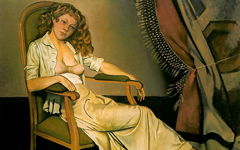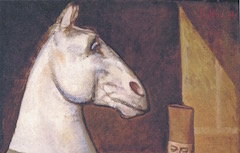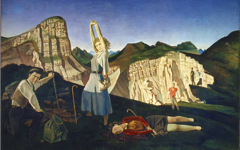Balthus’ Portrait of André Derain (1936)

Balthus, Portrait of Andre Derain (1936) oil on canvas. Museum of Modern Art, New York.
Click image to enlarge.
Balthus’ Portrait of André Derain is a good example of how the figure of one artist is often based on an earlier one. In this case Balthus fused Derain's face with that of Poussin, the greatest painter of 17th century France. This is not surprising because Poussin was one of Balthus’ heroes throughout his life. Balthus, born in France, identified with the French master so, in giving Poussin's features to Derain, Derain becomes an alter ego of Balthus. It also suggests a common belief among poetic painters that they are reincarnations of one another.
Click next thumbnail to continue

Left: Detail of Balthus' Derain
Right: Detail of Poussin's Self-Portrait (1650)
Click image to enlarge.
Derain’s head, however much it may have resembled his own, clearly borrows some features from Poussin's well-known Self-Portrait in the Louvre. The frown, the bags under the eyes, the faint mustache, the shape of the mouth and chin are all Poussin's. Although some features may have matched Derain’s as well, it is unlikely that all of them did.
Click next thumbnail to continue

Left: Detail of Balthus' Derain
Right: Detail of Poussin's Self-Portrait (1650)
Click image to enlarge.
Should there be any doubt about Balthus' self-representation in Derain's figure (based on his muse, Poussin), consider "Derain's model" to his side. She, in reality, was Balthus' "model", Antoinette de Watteville, who became his wife the next year. She did have long wavy hair but Balthus has rearranged it to resemble even more closely Poussin's. By giving some of Poussin’s appearance to both artist and model, Balthus clearly states that every painter paints himself.
Click next thumbnail to continue

Left: Balthus, Portrait of Andre Derain (1936)
Right: Poussin, Self-Portrait (1650)
Click image to enlarge.
Lastly, and not so obviously, even the composition is based on Poussin's Self-Portrait in that both include an artist, a much smaller secondary figure to their side, a doorway on the rear wall and a stack of framed pictures. And in a neat rhyme the frame of Balthus' doorway matches the actual frame on Poussin's portrait to suggest, perhaps, that Balthus' own art is to be found through the doorway of Poussin's painting.
More Works by Balthus
Learn how to deconstruct a portrait by Balthus using a few simple principles

Balthus’ The White Skirt (1937)
Notes:
Original Publication Date on EPPH: 06 Dec 2010. | Updated: 0. © Simon Abrahams. Articles on this site are the copyright of Simon Abrahams. To use copyrighted material in print or other media for purposes beyond 'fair use', you must obtain permission from the copyright owner. Websites may link to this page without permission (please do) but may not reproduce the material on their own site without crediting Simon Abrahams and EPPH.


